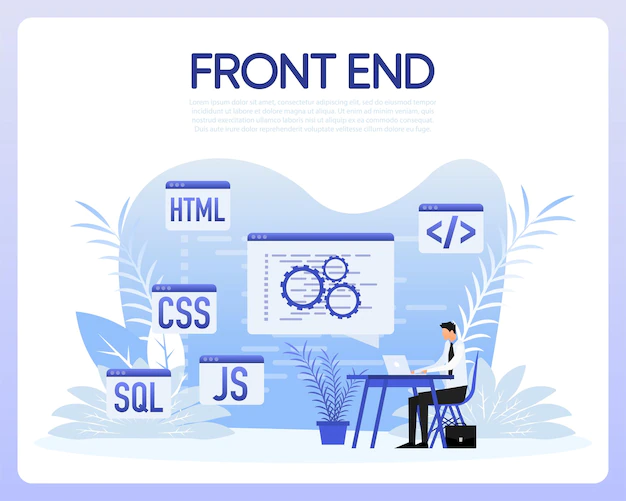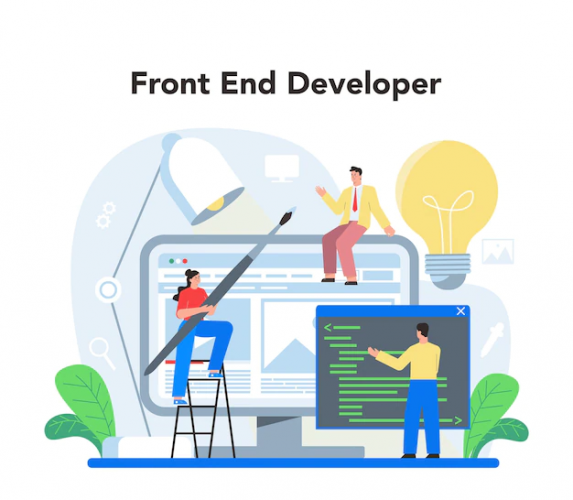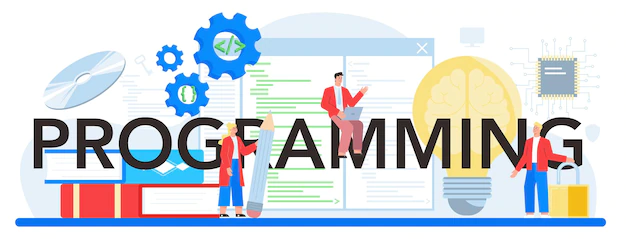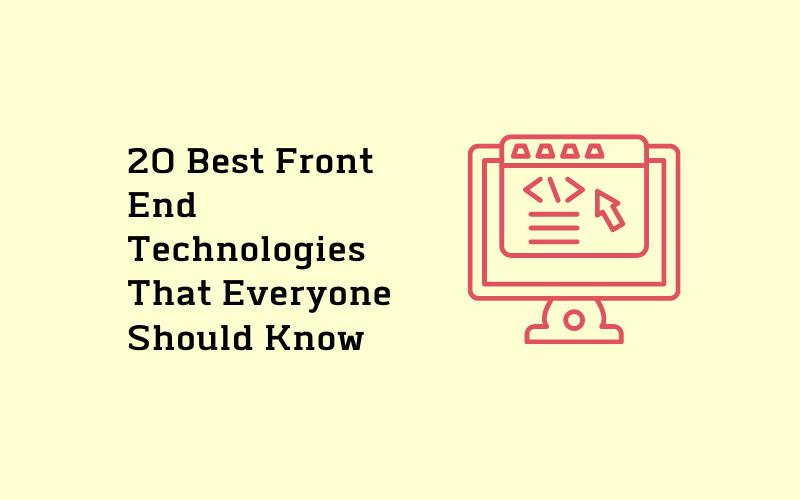
Any software infrastructure’s success depends on its front end, which interfaces with the user and draws their attention to essential features. Back-end technologies allow for smooth running applications, but the user experience on these sides keeps people engaged and coming back again.
The field of front-end development is broad and constantly changing. To stay ahead, it’s important to be familiar with the latest technologies. One of the biggest challenges with front-end development is constantly changing. The front-end development tools and techniques for developing websites change quickly, so you must keep up by learning new things daily.
Here are 20 of the best Frontend technologies you should know. From CSS to JavaScript, these developer tools will help you create beautiful and user-friendly websites and applications. So whether you’re a seasoned developer or just starting, make sure to add these technologies to your toolkit.
What is Front-end Development?
Front-end development is the part of web design that makes up a user interface. It can be anything from building websites with images and text to drawing UIs on paper before translating them into code, making them visible to users online.
The back-end development process ensures that your application or website runs smoothly, while the front end does all of its work to ensure you can use it effectively.
It’s important to use mobile-first and responsive web design to create a website that works for everyone. Mobile devices are used by nearly all internet users nowadays. Therefore, you should develop your site so it can be easily viewed on small screens, like smartphones or tablets.
The goal of frontend developers’ skills is to create a site, web, or desktop application that can be used by many people worldwide with different devices.
Top 20 Frontend Technologies:
Learning multiple front-end languages can be a huge advantage for developers looking to grow their careers.
HTML:
HTML is the foundation for Front-end development and will remain an important part of web design. Thanks to this technology, you can create webpages with all sorts of basic elements like buttons or forms, which provide your users with options within their browser interface, allowing them easier access to whatever needs.
HTML5 is an innovative technology that uses new media types, such as video and audio. This development has eliminated Adobe Flash Player in most cases due to its native support within HTML code itself without relying on third-party plugins or extensions.
HTML or HyperText Markup Language is the code that makes web pages work. The code tells the browser how to display text and images on your website.
JavaScript:
JavaScript is a programming language that has been around for 25 years. It’s well known in the web development world because it provides dynamic capabilities to websites and applications, which were previously impossible with other technologies.
Thanks to JavaScript, the web is now dynamic. A page can have different pieces of content at any given time, and those changes will be visible on your website without anyone having to do anything more than refresh their browser window.
JavaScript came about, enabling interactivity. This led to an entirely new world of online experiences that we take for granted today, like scrolling through pages on your website or clicking a button to make something happen in response.
JavaScript is everywhere these days, and for a good reason. It’s the go-to language when you need to do something quick or complex in your web application, like building an app that can sense what objects are around it with powerful APIs built right into browsers.
CSS:
CSS, or Cascading Style Sheet language, is a way to manage visual details in HTML documents. It can give your website an extra touch of class and make it stand out among other sites with similar layouts but less attention paid to styling things properly.
In keeping with its reputation for innovation, CSS3 was recently upgraded to include modularized specifications. With this upgrade comes more flexibility and a better chance of successfully implementing the design you want without any problems along your journey.

Freepik
React.js:
React is a UI library developed by Facebook for building user interfaces. It was created as part of the company’s JavaScript development effort. Still, it has grown into an independent project with active support from its creators at a large number of companies around the world.
React.js has become one of the most popular libraries for frontend web development in recent years. It’s used by major global companies like Facebook and Instagram to develop their sites, which makes it an excellent choice when you want your project done quickly with high-quality results.
React is a popular library that uses MVC architecture. The presentation layer holds all of your UI logic, while data access resides in another part of it completely separate from where you do business objects or routes happen. This makes sure no confidential information gets out of hand without being intended to.
The React library has been proven to be the most engaging and user-friendly way of developing UIs. It’s perfect for both web applications as well mobile apps.
React Native:
React Native is an exciting new development in mobile application frameworks. It offers developers a way to build dynamic applications for Android, iOS, and other platforms with just one framework that can be used on desktop computers and phones or tablets.
It is a hybrid app development platform that enables developers to develop apps compatible with multiple platforms. The primary objective of React native, as the name suggests, is enabling native features on various devices and achieving this through its JavaScript library called “React.”
The greatest feature of React Native is its ability to reuse code. The fact that we can see changes almost instantly as they happen is quite useful when working on multiple platforms.
Ionic:
Ionic is a free and easy way to develop high-quality iOS, Windows & Android apps. The same codebase can be used on mobile and desktop devices, making it possible to create engaging user experiences and save time in developing simultaneously across different platforms.
With the help of this platform, you can develop hybrid mobile applications capable enough to compete with native app development. You will be surprised at how easy it is. All features come fully customizable, and there’s even a command line interface for those who want to avoid coding knowledge in their project management workflow.
Ionic’s versatile themes and components will make your application stand out in the market.

Freepik
Angular:
Angular is a powerful and versatile Front-end framework that can create sophisticated web applications. It has been incorporated into the MEAN stack or MongoDB, ExpressJS & Angular HTML rendering engine, and Node JS, which powers it all.
TypeScript is a language that extends JavaScript with static typing, permitting stronger type safety for detecting errors quickly. This means you can use it in place of standard JavaScript without any worries about making mistakes and crashing your site or application due to confusing variable names.
With its versatility, the Angular framework can be used for various purposes. You could build progressive web apps or incorporate them with other frontend technologies like Cordova to develop native mobile applications that are near-perfect replacements for their existing ones on iOS and Android devices.
A framework is an excellent tool for rapid UI development. It enables software engineers to work more efficiently and create polished user interfaces in no time at all with its templates, which saves them from having to write completely from scratch every single one of these components by hand.
Vue.js:
The lightweight and adaptable framework, Vue.js, has been used to develop interactive UIs (User Interfaces) and SPAs. These single-page applications can be loaded onto the browser quickly without any loading times incurred by dynamically generating HTML pages whenever something changes in your codebase.
Vue.js is an extremely easy-to-use framework that can be implemented with minimal effort because of its lightweight nature and Model View – View Model architecture pattern, which makes it perfect for beginners or those looking to try something new.
With Vue, your views are powered by HTML and CSS frameworks. It also has a built-in library to make things easier for you. Vue.js is a framework that has become very popular recently for its simplicity and easy customization features. The most notable projects built with Vue include 9GAG, GitLab, or Nintendo, but many others are just as cool, like Behance, which allows you to post your work on social media channels through this app.

Flutter:
The Flutter software development kit (SDK) is a product of Google designed to make it easier for developers across all platforms. Along with the sleek language Dart and the powerful graphics engine Skia, building cross-platform apps has never been simpler.
The most exciting thing about Dart is how much faster it will be than JavaScript. Not only does this mean that your pages load quicker, but there are also no more glitches or compatibility issues with older browsers like Skia. It works by abstracting away from the developer what graphics needs to occur on each platform for a site to look good across all devices – including desktop computer screens.
With Flutter, you can create stunning mobile apps in no time. Its widgets are customizable and easy to use, saving even more of your precious developer resources.
Node Package Manager (npm):
Node Package Manager, or npm commonly known, is a simple yet powerful tool used to manage packages in the ever-growing JavaScript runtime environment. It’s primarily intended for use with Node JS but can be applied anywhere there are demands on managing third-party libraries and their exports.
JavaScript is a language that touches every website on the world wide web, and it’s no surprise why npm has taken over as one of Earth’s most popular software registries.
An essential frontend technology that allows developers to reuse code from other modules. With over 350,000 packages available on npm, this resource has become so popular in less time than expected.
Bootstrap:
Some of the most popular web design today is based on a styling framework called Bootstrap. This tool provides templates for typography, forms, buttons, and other interface modules, making it easy to create beautiful interfaces without writing too much code.
With Bootstrap, you can build the front end of responsive sites easily and quickly. The prebuilt components are made to fit seamlessly into any theme or design aesthetic.
One key feature that makes Bootstrap so popular is its mobile-first design. This means front-end web developers can expand their designs to fit web development rather than having everything tailored for smaller screens first.
Monorepo:
Monorepo is a new architectural concept that makes it easy to share components and assets between multiple projects. It’s an excellent way of managing code for your different endeavors since you have just one source with all the information about each project stored within its repository.
Gatsby:
Gatsby is a frontend framework that provides developers with the best of both worlds – it combines all three major trends in frontend development: React, GraphQL and webpack. This means you can build fast, responsive user interfaces while enjoying an excellent “development experience.”
The Gatsby framework offers many prebuilt tools, like image optimization and code-splitting. It also has an advanced data layer based on GraphQL that allows you to make more specific requests than ever.
Next:
Next, we have a tool to help you create websites at record speed. It can generate both static websites and server-side rendered ones, so it’s easy for your business to use depending on their needs.
The next framework provides outstanding performance by employing pre-rendering, an optimization technique that allows the page to be loaded before it is fully written. Next’s SEO friendliness makes this a popular choice among web developers today.
Micro Frontends:
Micro frontends take a different approach to building and designing your website. With this, you can break down the entire application into smaller features which will be managed by separate teams on their code repositories for easier management of updates or new features addition without disrupting anything else since it’s all happening independently from each other.
Tailwind:
Tailwind is a framework that lets you create styles right in your HTML markup with just one click. It makes it super easy and fast to develop multiple versions of designs without having any extra steps involved, like copying/pasting codes or worrying about specificity issues, all while keeping things organized at every level.
Three.js:
Many libraries create 3D web graphics and animations, but Three is one of the most popular. It can be used for anything from creating animated gifs to building interactive examples on websites like Product Hunt or Dribbble.
Remix:
With Remix, you can fetch data and serve HTML directly from your Back-end with server-side rendering. It’s built with additional features like error boundaries to make it easier for users on the web to navigate through pages of content without getting lost or timing out. This also helps them stay engaged since they can see how much more there will be when their browser finishes loading.
Design System:
Design systems are useful because they allow designers to create more consistent and reusable designs. For instance, if you decide to use Material-UI as your design system for products in the future – there’s a high chance that any new components will appear on their documentation page.
Some of the most popular design systems are Chakra.UI, Ant Design, and MUI all have various features that make it easy to create great-looking apps for any project you may have on hand.
PWA:
Progressive web apps are designed to work well in the browser, offering a similar experience as native apps without any additional installation or verification steps.
With the recent rise in popularity for PWAs, your smartphone will prompt you with a question if you want to install it on screen. The benefits are clear – they make browsing faster and more secure by not having any extra steps between website visitors and content.
Conclusion:
Front-end development is a necessary component for building nearly any software. The use of modern technologies can give you an edge in today’s competitive market.
This list is a great place to begin for anyone interested in learning more about front-end technologies. The list above is just a small representation of the many technology options available for web and mobile development. We encourage you to explore all of them and find the ones that best fit your needs. With so many great front-end technologies, there’s no excuse not to create beautiful, responsive designs that look amazing on any device. What are you waiting for? Start learning today.
